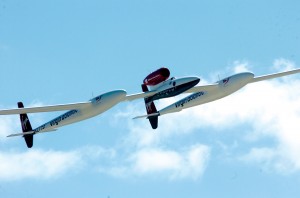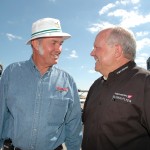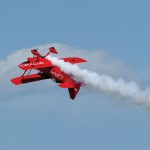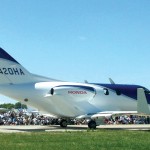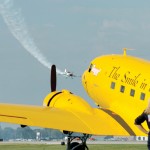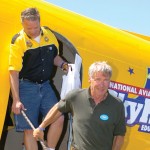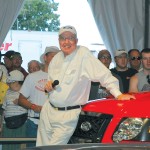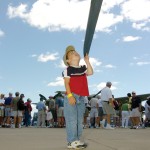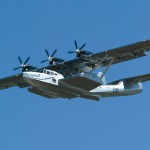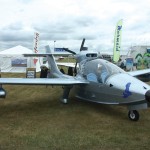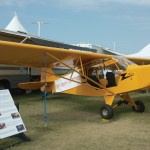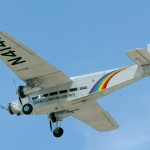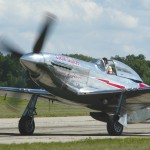By Henry M. Holden
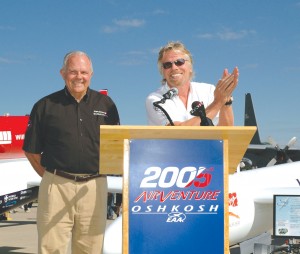
Sir Richard Branson applauds Steve Fossett, after the announcement that the Virgin Atlantic GlobalFlyer will again take to the skies on an “Ultimate Flight.”
Each year the Experimental Aircraft Association tries to create a better convention and fly-in than the previous year, and each year they succeed. This year, attendance for EAA AirVenture Oshkosh 2005, held July 25-31, was up about seven percent to approximately 700,000, with more than 10,000 aircraft, including 2,927 show planes, comprised of a record 1,267 homebuilts, 924 vintage aircraft, 386 warbirds, 196 ultralights, 130 seaplanes and 24 rotorcraft.
SpaceShipOne
This year the soul of AirVenture was SpaceShipOne/White Knight. Scaled Composites, using Burt Rutan’s design, was the first private company to successfully launch a manned vehicle into space. On Oct. 4, 2004, the aircraft flew the second flight needed to win the $10 million Ansari X PRIZE within a two-week period. It flew civilian astronaut Brian Binnie to a record altitude of 367,442 feet (69.6 miles) above Earth’s surface.
It was announced that Scaled Composites will manufacture the first two six- to eight-seat SpaceshipTwos. This aircraft/spaceship will be about the size of a large business jet and is intended to take passengers paying $200,000 into a brief suborbital flight at an altitude of 460,000 feet. The flight will cover about 200 miles; there will be about five minutes at near zero gravity. Rutan said his company plans to transfer the technology from SS1 to SS2.
“Scaled Composites will do the research and development, and then hand over those designs to Virgin Galactic, and a new company, The Spaceship Company, which will be the manufacturer for what we envision as a large fleet of spaceships,” Rutan said.
The aerospace production company, a joint venture between Virgin Galactic and Scaled Composites, will manufacture launch aircraft, spaceships and support equipment and market them to spaceline operators. The launch customer, Virgin Galactic, has made a $130 million requisition for five of the suborbital craft, and plans to use the fleet to develop a space tourism industry.
Sir Richard Branson and Rutan made it clear they expect many more, and already are thinking about the next generation of suborbital, and eventually, orbital commercial spaceships. Virgin Galactic expects to fly as many as 35,000 passengers over the next 10 years. Flights could begin as early as 2008. Virgin Galactic Airways will market the spacecraft.
“We’ll use the expertise we had in building Virgin Atlantic from scratch, with one airplane, 21 years ago,” Branson said. “We’ll bring that same expertise into trying to develop a really exciting space company.”
Branson said the principal aim isn’t to make money.
“Our principal aim is to reinvest any money we make into space exploration,” he said.
At a press conference announcing the SpaceShipTwo project, Sir Richard Branson accepted checks for $200,000 each from two individuals who are booked on the first flight of the SS2. One hundred people have signed contracts and another 178 so far are seriously interested.
After AirVenture ended, SpaceShipOne departed for Washington, D.C., where it will be prepped for installation in the Milestones of Flight hall in the Smithsonian National Air and Space Museum, alongside the 1903 Wright Flyer.
GlobalFlyer
The Virgin Atlantic GlobalFlyer, delayed a day by weather, landed on Wednesday, July 27. Steve Fossett, who flew the Burt Rutan-designed aircraft to AirVenture, set a record in March for his solo, non-stop, un-refueled flight around the world. The 67-hour flight covered a distance of nearly 19,880 nautical miles (22,862 statute miles).
At AirVenture, Fossett and Sir Richard Branson announced that the Virgin Atlantic GlobalFlyer will begin the “Ultimate Flight” in February 2006, to go 4,000 miles further than any plane or balloon has ever flown, nonstop and without refueling, in about 90 hours.
The twin-engined Voyager (also designed by Burt Rutan, and flown by Dick Rutan and Jeana Yeager) holds the current record for the Federation Aeronautique Internationale’s “absolute world record for distance without landing.” Voyager flew for 24,987 miles in 1986. The longest flight by a balloon is held by Breitling Orbiter 3, which flew for 25,361 miles in 1999.
Fossett plans to take off from Salina, Kansas; he will then circumnavigate the globe before flying across the North Atlantic a second time, landing at an airport near London. GlobalFlyer lost 3,100 pounds of fuel inadvertently on the first record-setting flight.
“Without losing any fuel, this airplane should be able to fly 29,000 miles,” Fossett said.
Very Light Jets
It appears that the long-incubating very light jet market has suddenly hatched, with several examples flying into AirVenture this year.
Cessna left little doubt it’s serious about claiming its share of the market. Cessna has delivered more than 4,200 Citations in the last 30 years, including more light jets than all other manufacturers combined. Tuesday saw the arrival of its latest, the Mustang prototype. The Mustang is Cessna’s newest entry-level business jet. The latest addition to the Citation line made a dramatic entrance as CEO Jack Pelton did a flyby before landing. Currently, Cessna has over 240 firm orders for the $2.2 million Mustang. They anticipate single-pilot certification and first customer delivery in late 2006 for the six-passenger aircraft.
For several decades, Honda has been a household word, known for its cars, generators and motorcycles. On Thursday, the long-awaited and mysterious HondaJet flew into AirVenture, making its world debut. This is a new design, not adopted or adapted from another manufacturer’s drawing board. The six-person jet has a maximum speed of 393 knots, and an altitude of 43,000 feet. Honda estimates its new jet will burn 30 to 40 percent less fuel than comparable sized business jets. The project manager, and vice president of R&D, Michimasa Fujino, said, “I’m sure that in the very near future there will be a revolution in small airplane transportation systems…and through new hardware design and concepts, Honda will make a contribution to the American aviation industry.”
AirVenture 2005 saw the first public flight appearances of Eclipse Aviation’s Eclipse 500. On July 26, it climbed to its service ceiling and reached its maximum operating speed for the first time. Aircraft 502EA reached FL410 and accelerated to its maximum operating speed of 285 knots.
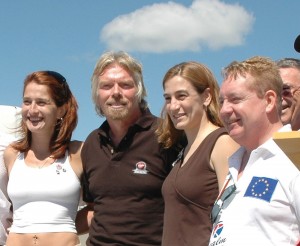
Sir Richard Branson poses with L to R: Lina Borozdina, a biochemist born in Russia who mortgaged her home for a ticket on SS2; US exobiologist Loretta Hidalgo; and Realm CEO Tom Higgins, founder of Irish Physics Live, who presented a check for his $200,00
Aircraft Investor Resources LLC, aka Epic Air, creator of the Epic LT, a single-engine turboprop, made its entry into the VLJ market Tuesday, when it unveiled its new jet design, but only in mock-up. The aircraft is being developed in a joint venture with Tbilisi Aviation Machine LLC, and will feature a carbon-fiber composite airframe powered by two Williams FJ-33A engines. The seven-seat jet will have a cruise speed of 420 knots, a ceiling of 41,000 feet, and a range of 1,400 nautical miles with IFR reserves.
Adam Aircraft displayed their first customer aircraft, A500 S/N 0005, and the company’s VLJ entry, the A700 AdamJet. The company celebrated recent victories, including the May type certification of the A500 centerline twin, by sponsoring a media lunch on July 28, hosted by Joe Walker, president and COO.
Light Sport Aircraft
The light sport aircraft type is becoming a gathering force in GA, and enticing a new market of flyers. The largest collection of light sport aircraft ever assembled at Oshkosh was on display located just south of AeroShell Square. The LSA Mall included between 35 and 40 aircraft parked together so visitors could compare, contrast and ask questions of the manufacturers.
Among the aircraft appearing were some that have never been seen in the United States before. Priced from $18,000 to $100,000 (about one-third that of a traditional certificated aircraft), there appeared to be something for everyone interested in the newly emerging type. At least 20 LSAs had been sold by Saturday morning.
On the high end of the LSA spectrum is the Czech Republic’s latest entry from Czech Aircraft Works, S.R.O., the Mermaid. Already assembled, the Mermaid, when certificated, will be the first LSA amphibian to comply with the LSA guidelines, and has an $85,000 price tag.
The 14 light sport aircraft certificated in the first year of the type has led to a rush of kits to the market. The low-end kits are running from $7,300 for a KR-2S to $19,000 for a Sonex, with the high-end kits priced in the luxury car class. One of the most promising kits is from Zenith Aircraft, one of the prominent kit-building companies in the world. Their latest addition to their fast growing line is the Zodiac XL Quick Build Kit. This kit provides the maximum preassembly of standard parts. It saves hours of time, and is simple to assemble. All holes are drilled and deburred, so the builder has smooth metal surfaces to handle and fit.
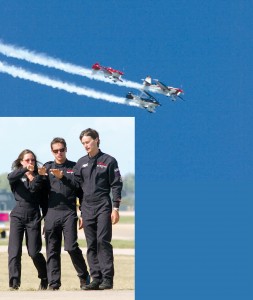
2005 Stars of Tomorrow Jessy Panzer, Nick Nilmeyer (team captain) and Eric Tucker go through their routine; Panzer flies the One Design (top left in formation), Nilmeyer an Extra 300 (top right) and Tucker a Pitts S-2C.
Assembly is close to foolproof. The parts are assembled at the factory to make sure everything fits properly, and then disassembled and packed for shipment. For $23,975, which is in line with the philosophy of the category, flying at an affordable price, the kit includes the leather upholstery kit, and two large fuel tanks, 15 gallons each, for added range and endurance.
The kit allow for a choice of Jabiru, Continental 0-200, Rotax 912S, Corvair and other power plants. The kit includes all airframe parts including tricycle landing gear, canopy, controls, and all hardware to finish the airframe assembly. Not included are the power plant, instrument package and paint. Assembly time for the XL is said to be at least 50 percent less than with standard kits, and qualifies for the 51 percent amateur built experimental category.
Another entry, an Italian design, manufactured in the Czech Republic by ZLIN Aviation S.R.O., is the Savage, a Piper Cub look-alike. While the basic kit starts at $27,000, when you finish adding options it costs almost as much as the two-place, turn-key, ready-to-fly 80-hp Savage at $53,000.
The LSA regulations were written to spawn simplified and lower-cost aircraft, which are designed to recruit new pilots, and recertify older pilots. With 14 airplanes now approved under light sport aircraft provisions, and more coming, the push is on to put pilots in them. Flight training for this category is estimated to cost about $2,000 to $3,000.
As the LSA market emerges, a wide range of airplanes and prices will follow. In the end, however, the market will define the price of LSA aircraft. For now, lack of a well-defined group may mean a lack of mass production (in the U.S.), and the absence of other new low-cost aircraft such as the Zodiac XL Quick Build aircraft, and the KR-2S.
Vintage aircraft
Thirteen years ago this author saw a pile of broken and disconnected parts someone called “Glacier Girl,” the remains of a P-38 Lightning recovered from a Greenland icecap. Many said it couldn’t be rebuilt. This year it flew back to Oshkosh as one big connected part. Remarkably, “Glacier Girl” is about 80 percent original parts, according to Bob Cardin, project manager for Glacier Girl. He claims it’s the only World War II airplane still flying with its original landing gear.
Glacier Girl was fresh from the factory and on her way to Great Britain when she and other aircraft had to ditch on the icecap. The ice slowly enveloped her, until she was buried in more than 250 feet of ice. She remained there for 50 years, until she was recovered.
A one-of-a kind Dornier DO-24ATT made its first appearance at AirVenture. It’s currently powered with three P&W PTA-45B turboprops (which replaced the original BMW radials), arrayed across the high wing. Built in Germany, in 1944, it served after the war in the Spanish navy, and later as a Dornier testbed. Since 2004, it has been flying on behalf of UNICEF, to promote education and awareness for the children of the world.
A one-of-a-kind reunion of tri-motor aircraft included EAA’s 1929 Ford 4-AT-E, Grand Canyon Airways’ 1929 Ford 5-AT-74, and Greg Herrick’s 1927 Ford 4-AT-10, which is the tenth Tri-Motor built and is the oldest surviving example of the 199 Ford produced. Other tri-motors involved were a Dornier DO-24 amphibian; a Junkers Ju-52; the only surviving Bushmaster; a one-of-a-kind Kreutzer Air Coach; and a Stinson Model “T” that is the oldest surviving former American Airlines airliner. Only the Kreutzer didn’t fly during the shows.
AirVenture also featured a unique reunion of World War II bombers, to commemorate the 60th anniversary of the end of World War II. Included were five B-17s, several B-25s, a B-24 and the only airworthy B-29 in the world. Many flew in the daily warbird air shows.
Guest Speakers
Carroll Shelby, one of the automotive industry’s greatest legends, as a driver, owner, team manager, manufacturer, consultant and visionary, shared his personal stories at the Ford hangar.
Among those who appeared at the Theater in the Woods were Burt Rutan, X-15 test pilot Scott Crossfield, SpaceShipOne pilots Mike Melvill and Brian Binnie, Steve Fossett, Sir Richard Branson, EAA Young Eagles Chairman Harrison Ford, X PRIZE Foundation Chair Peter Diamandis, and Bob Cardin, one of the leaders of the P-38 Glacier Girl restoration project.
For further information on AirVenture 2005, visit [http://www.airventure.org].
- The Eclipse 500 made its first public flight at AirVenture 2005.
- L to R: Burt Rutan and Steve Fossett converse after a press conference in which Fossett announced his next flight in the GlobalFlyer.
- Sean Tucker thrills the crowd in the Oracle Challenger.
- The mysterious HondaJet making its first public appearance.
- During the afternoon air show, aerobatic pilot Michael Goulian “flies into the smiling mouth” of Duggy, the National Aviation Hall of Fame’s ambassador for its Skyreach education program.
- After getting some “right seat” time in the historic DC-3, Young Eagles Chairman Harrison Ford exits “Duggy” followed by “Duggy” cartoon creator Mitch Carley.
- Carroll Shelby recounts his history in the Ford hangar.
- A young aviation enthusiast studies a propeller blade on “Duggy.” The restored Douglas DC-3 owned by Bob Odegaard is used to promote the National Aviation Hall of Fame’s Skyreach education program.
- A one-of-a kind Dornier DO-24 ATT tri-motor amphibian registered in the Philippines made its first appearance at AirVenture.
- The Mermaid is the Czech Republic’s latest entry from Czech Aircraft Works, S.R.O.
- Pro Pilot editor/publisher Murray Smith pauses after a day of gathering information.
- The Savage, a Piper Cub look-alike originally from Italy, was recently certified.
- Grand Canyon Airlines’ Ford Tri-Motor 5-AT-74 was purchased new for $55,000 in 1929.
- Jimmy Leeward, in his P-51 Mustang, “Cloud Dancer.”













